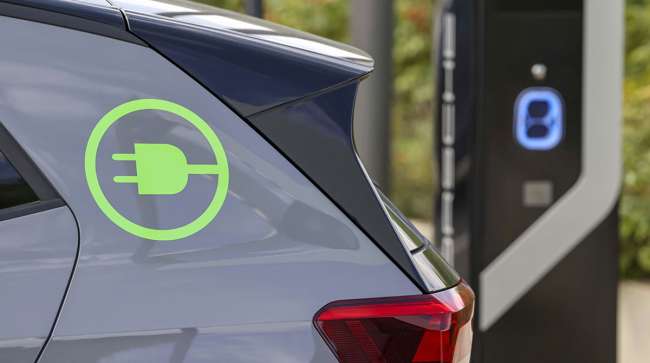Associated Press
EPA Pollution Limits Aim to Boost US Electric Vehicle Sales

[Stay on top of transportation news: Get TTNews in your inbox.]
WASHINGTON — The Biden administration is proposing strict new automobile pollution limits that would require as many as two-thirds of new vehicles sold in the U.S. to be electric by 2032, a nearly tenfold increase over current electric vehicle sales.
The proposed regulation, announced April 12 by the Environmental Protection Agency, would set tailpipe emissions limits for the 2027 through 2032 model years that are the strictest ever imposed — and call for far more new EV sales than the auto industry agreed to less than two years ago.
If finalized next year as expected, the plan would represent the strongest push yet toward a once almost unthinkable shift from gasoline-powered cars and trucks to battery-powered vehicles.
A look at what the EPA is proposing, how the plan serves President Joe Biden’s ambitious goal to cut America’s planet-warming greenhouse gas emissions in half by 2030, and whether the auto industry can meet the new EV targets:
EPA’s proposed vehicle emissions standards would avoid nearly 10 billion tons of CO2 emissions – which is the same as more than *double* the total carbon emissions from the U.S. in 2022!https://t.co/dAvU6FXcsa — U.S. EPA (@EPA) April 12, 2023
Q. What is the EPA proposing?
A. The proposed tailpipe pollution limits don’t require a specific number of electric vehicles to be sold every year, but instead they mandate limits on greenhouse gas emissions. Depending on how automakers comply, the EPA projects that at least 60% of new passenger vehicles sold in the U.S. would be electric by 2030 and up to 67% by 2032.
For slightly larger, medium-duty trucks, the EPA projects 46% of new vehicle sales will be EVs in 2032.
EPA Administrator Michael Regan called the proposal "the most ambitious pollution standards ever for cars and trucks,'' and he said it would reduce dangerous air and climate pollution and lower fuel and maintenance costs for families.
The agency will select from a range of options after a public comment period, Regan said. The rule is expected to become final next year.
Q. What is the auto industry saying about the proposed rules?
A. John Bozzella, CEO of the Alliance for Automotive Innovation, a trade group representing most automakers, called the EPA proposal “aggressive by any measure” and wrote in a statement that it exceeds the Biden administration’s 50% electric vehicle sales target for 2030 announced less than two years ago.
Car makers globally have earmarked $1.2 trillion toward electrification & are rapidly rolling out new plug-in models.
"Even w/ positive #EV sales momentum and product excitement.. this requires a massive, 100-year change to the U.S. industrial base and the way Americans drive.” https://t.co/oTsGTsx3I4 — Alliance for Automotive Innovation (@autosinnovate) April 10, 2023
Reaching half was always a “stretch goal,” contingent on manufacturing incentives and tax credits to make EVs more affordable, he wrote. It remains to be seen whether those provisions are enough to support electric vehicle sales at the level the EPA has proposed, he wrote.
“The question isn’t can this be done, it’s how fast can it be done,” Bozzella wrote. “How fast will depend almost exclusively on having the right policies and market conditions in place.”
European car maker Stellantis said officials were “surprised that none of the alternatives” proposed by EPA "align with the president’s previously announced target of 50% EVs by 2030.''
Q. How will the proposal benefit the environment?
A. The proposed standards for light-duty cars and trucks are projected to result in a 56% reduction in projected greenhouse gas emissions compared with existing standards for model year 2026, the EPA said. The proposals would improve air quality for communities across the nation, avoiding nearly 10 billion tons of carbon dioxide emissions, more than twice the total U.S. CO2 emissions last year, the EPA said.
The plan also would save thousands of dollars over the lives of the vehicles sold and reduce U.S. reliance on approximately 20 billion barrels of oil imports, the agency said.
Q. Is the EPA proposal realistic?
A. With electric vehicles accounting for just 7.2% of U.S. vehicle sales in the first quarter of this year, the industry has a long way to go to even approach the Biden administration’s targets. However, the percentage of EV sales is growing. Last year it was 5.8% of new vehicles sales.
Many auto industry analysts say it will be difficult for automakers to meet the projected sales percentage. The consulting firm LMC Automotive, for instance, said new EV sales could reach 49% in 2032 but are unlikely to go above that, citing high prices for EVs compared with gas-powered cars.

Anthony Marshall of UPS shares the gold standard for an efficient and effective EV maintenance cycle. Hear the program above and at RoadSigns.TTNews.com.
A new poll released April 11 shows that many Americans aren’t yet sold on going electric for their next cars, with high prices and too few charging stations the main deterrents. Only 19% of U.S. adults say it’s “very” or “extremely” likely they will purchase an EV the next time they buy a car, while 22% say it’s somewhat likely. About half, 47%, say they are unlikely to go electric, according to the poll by The Associated Press-NORC Center for Public Affairs Research and the Energy Policy Institute at the University of Chicago.
Regan called the 2032 goal ambitious but achievable.
“I believe we can (meet the goal), because we’re following the market trends,'' he said, citing more than $120 billion of private investment in EVs and batteries in the past two years.
“This is the future,'' Regan added. "The consumer demand is there. The markets are enabling it. The technologies are enabling it. And this isn’t something that we just started yesterday. This has been part of President Biden’s vision from Day One.''
Q. Why is the tailpipe rule so important?
A. Transportation is the largest source of carbon emissions in the U.S., accounting for about 27% of greenhouse gas emissions in the U.S. in 2020, according to the EPA. Electric power generates the second largest share of greenhouse gas emissions at 25%.
Environmental groups say stricter tailpipe pollution standards are needed to clean the air we breathe and slow the impacts of severe weather events such as hurricanes, tornadoes and wildfires.
“Done right, these (new rules) will put the U.S. on the path to end pollution from vehicle tailpipes — while also slashing our dependence on oil, creating good domestic jobs and saving consumers money on fuel,” said Manish Bapna, president and CEO of the Natural Resources Defense Council.
Margo Oge, former head of EPA’s Office of Transportation and Air Quality, called the tailpipe rules “the single most important regulatory initiative by the Biden administration to combat climate change and to really reduce the worst outcomes of climate change.”
Want more news? Listen to today's daily briefing above or go here for more info
Q. What else is the Biden administration doing to promote EVs?
A. Besides stricter pollution rules, tax credits for EV manufacturing and purchases included in the sweeping Inflation Reduction Act passed last year will help reach the tougher requirements, the White House and its allies said.
At present, many new EVs manufactured in North America are eligible for a $7,500 tax credit, while used EVs can get up to $4,000. However, there are price and purchaser income limits that make some vehicles ineligible. And starting April 18, new requirements by the Treasury Department will result in fewer new electric vehicles qualifying for a full $7,500 federal tax credit.
A smaller credit may not be enough to attract new buyers for EVs that now cost an average of $58,600 according to Kelley Blue Book.
— Krisher reported from Detroit.




